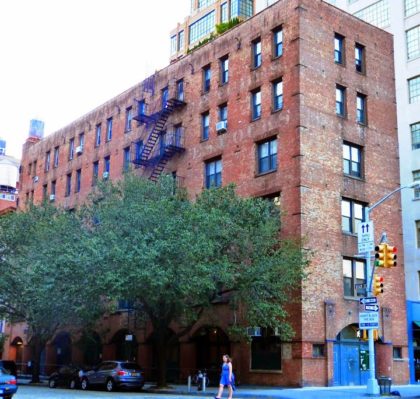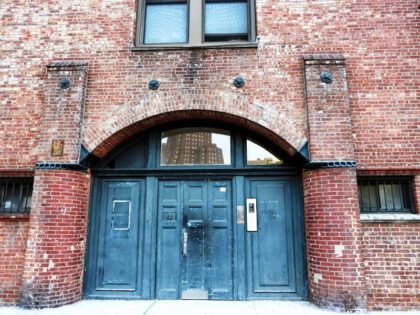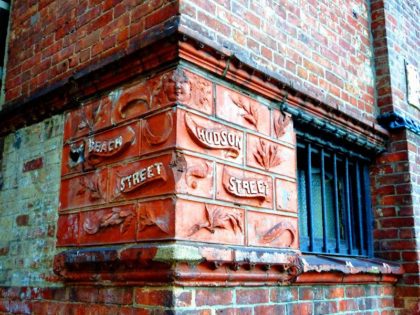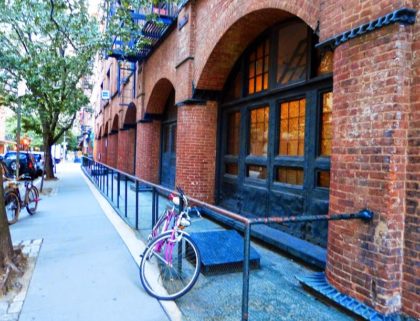The History of 135 Hudson
 Tom Miller, who writes about the history of Manhattan buildings at Daytonian in Manhattan, has allowed Tribeca Citizen to create a database of his Tribeca posts. If you enjoy these, and you will, then you should definitely check out his website, which also has write-ups about buildings all over the island. And don’t miss his book, Seeking New York: The Stories Behind the Historic Architecture of Manhattan—One Building at a Time.
Tom Miller, who writes about the history of Manhattan buildings at Daytonian in Manhattan, has allowed Tribeca Citizen to create a database of his Tribeca posts. If you enjoy these, and you will, then you should definitely check out his website, which also has write-ups about buildings all over the island. And don’t miss his book, Seeking New York: The Stories Behind the Historic Architecture of Manhattan—One Building at a Time.
··································
 In 1882, few of the once-grand houses that had graced the former St. John’s Park neighborhood still stood. The elegant park had been replaced in the 1860s by the Hudson River Railroad Company’s freight terminal. Wealthy homeowners abandoned their Federal-style brick mansions, which in turn were rapidly converted for business or razed for hulking warehouse buildings.
In 1882, few of the once-grand houses that had graced the former St. John’s Park neighborhood still stood. The elegant park had been replaced in the 1860s by the Hudson River Railroad Company’s freight terminal. Wealthy homeowners abandoned their Federal-style brick mansions, which in turn were rapidly converted for business or razed for hulking warehouse buildings.
No. 135 Hudson Street was an exception. Sitting on land the Cary family had owned since 1829, the old residence was now a boarding house. And despite the freight wagons that bumped along the stone-paved street outside, the manager of the house touted its respectable operation. On May 17, 1882 an advertisement appeared in The Sun under the category “Board and Rooms.” It announced, “Gentlemen, ladies, and married couples accommodated with board; none equal down town.”
But Edward M. Cary, who owned the property, recognized greater potential. Four years later he commissioned the architectural firm of Kimball & Ihnen to design a warehouse on the site of the house, stretching down Beach Street to engulf the lots at Nos. 43 through 47. Construction was begun in 1886 and completed a year later.
Cary was one of the principals of Cary Brothers, a storage firm whose business was scattered among three warehouses on Washington, Watts and Greenwich Streets. At the time architects were producing massive loft buildings in the neighborhood ornamented with terra cotta and carved stone. Kimball & Ihnen were not interested in display. In a surprisingly early example of “form follows function,” they produced a no-nonsense utilitarian structure that pretended to be nothing other than a warehouse.
 ··································
··································
Basically Romanesque Revival, the severe composition smacked of a medieval fortress—or prison. Gaping arches—one on the narrow Hudson Street façade and seven along Beach Street—were separated by rounded brick piers. The architects used the rounded shape not so much to add visual interest; but to eliminate the sharp corners which would be easily broken off by the in-and-out traffic of freight wagons. Iron tie rods, which elsewhere in the city added ornament by being cast as stars, starfish, or curlicues, here had the straightforward appearance of giant screw heads. These, like the iron anchor plates which were purposely left exposed, stressed the structural integrity of the building.
Kimball & Ihnen allowed for one astounding piece of architectural embellishment. At the corner of the building they installed a street sign composed of heavy terra cotta blocks. Nearly unique among Manhattan architectural signage, it announces the street names within cast leaves, plants and a remarkable face with flowing hair.
 Out of character with the rest of the structure, the fabulous terra cotta street sign is nearly unique.
Out of character with the rest of the structure, the fabulous terra cotta street sign is nearly unique.
··································
The often acerbic architectural critic Montgomery Schuyler praised the architects’ “abstinence.” Unable to pinpoint the architectural style, he said their unwillingness to over-ornament resulted in a building of “no style which yet has style.”
If the Cary Brothers had originally intended to consolidate their storage business into this one structure; the idea did not last long. A variety of merchants took space in the building. In 1890 Charles H. O’Neill & Company held the entire building. The firm imported millwork from the lumber mills of the vast Midwest logging areas. Unneeded lofts were leased to other firms. In May 1895 the company advertised, “To Let—Lofts, 28×132, power, elevator, office rooms.” Among the companies that shared the building with C. H. O’Neill was World Paper Co., which, despite the misleading name, manufactured shirts.
At the turn of the century No. 135 Hudson underwent a quick series of owners. In 1899 H. &. H. Sonn purchased it, but the liquor dealer sold the building the following year to Mariette Wilsey. She immediately leased it to Cornell & Underhill, suppliers of machinery and pipe. The structure was sold again in 1909 when real estate developer Augustus Bechstein, acquired it.
On April 21, 1910, it was announced that Bechstein had given at 10-year lease on the building to Crandall-Pettee Co., “a corporation.” The lease, active on May 1, had an initial rent of $7,000 (about $166,000 today) and increased to $7,500.
Crandall-Pettee was a new corporation, dealing in “grocers’, confectioners’, and bakers’ fixtures, utensils, and supplies,” as well as “fruit juices.” Originally the Crandall & Godley Company, founded in 1871, its building had burned to the ground on January 7, 1909. The principals, William Pfeiffer and William C. Pettee, reorganized under the new name. Pettee’s brother, Lyman, also joined the firm.
The business was highly successful and the partners made a comfortable living. Lyman Pettee earned a salary of about $237,000 in 1910, according to The New York Supplement in March 1913. The 10-year lease was renewed and Crandall-Pettee remained in the building into the 1920s. On March 20, 1920, the firm advertised for a new secretary. “Stenographer to operate Smith machine in wholesale house; good opportunity for ambitious girl, with advancement.”
 ··································
··································
On November 16 the following year, one of Crandall-Pettee Company’s truck drivers, Louis Coughlin, headed off to the Park Row Building to deliver a barrel of glucose. Coughlin had higher aspirations than being a deliveryman. He had applied to the New York City Fire Department and was on its eligible list. He expected to be hired in January.
The Park Row Building, at No. 13 to 21 Park Row, was owned by the multimillionaire August Belmont. As Coughlin rolled the heavy barrel onto the sidewalk elevator, the supporting chain snapped and the elevator fell into the subcellar below. Over a month later the New-York Tribune wrote that “Coughlin, who suffered various injuries which he says will cripple him permanently, is still in the Volunteer Hospital.”
With his hopes of being a fireman dashed, Coughlin summoned an attorney. He sued August Belmont personally for $100,000 damages; about a million and a quarter dollars today.
In 1922, Crandall-Pettee Company moved across the street to Nos. 144-150 Hudson Street. The following year The New York Times reported that Augustus E. Bechstein had sold the six-story building to Ernst Bischoff for $135,000. “The purchaser will use the building for his own business of wholesale chemicals,” the newspaper noted.
Ernst Bischoff Co., Inc., “manufacturers of technical and medicinal products,” would remain in the building for over two decades. Bischoff sold the building in 1946 and it would change hands again in 1950 and 1954.
By the last decade of the 20th century the Tribeca area was less about warehouses and delivery trucks than about trendy restaurants owned by celebrities and luxurious residential lofts. In 1990, No. 135 Hudson Street was converted to twelve massive “joint living/working quarters for artists”—just two per floor.
In 2014 a two-bedroom apartment, with 11 windows, went on the market for $1.775 million. As realty listings are wont to be, this one was historically misinformed. Calling the building the “converted Elsas Paper Company” (the Elsas Paper Company building was at Nos. 61 to 63 Varick Street), the realtors missed the construction date by a decade.
Nevertheless, Kimball & Ihnen’s severe and unadorned beauty at No. 135 Hudson Street is barely changed since 1887; save for the missing parapet that Mongomery Schuyler deemed “a device to mitigate the baldness of a flat roof in the absence of a heavy protective cornice.”
··································
Photo credits: Alice Lum.













